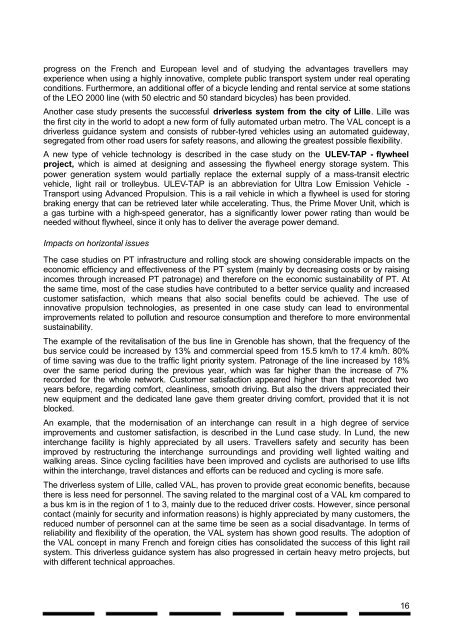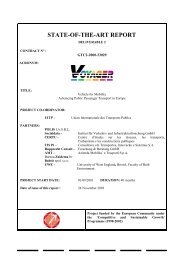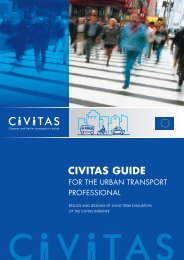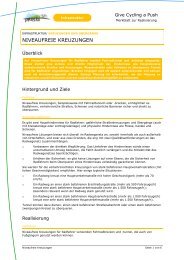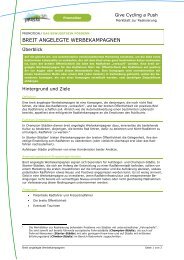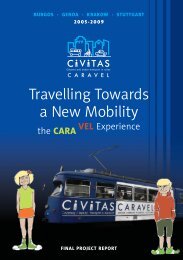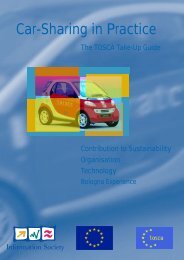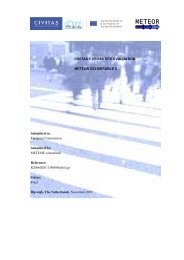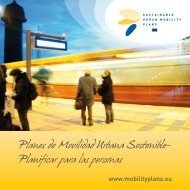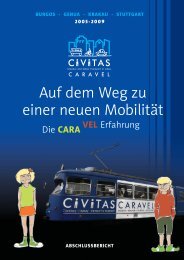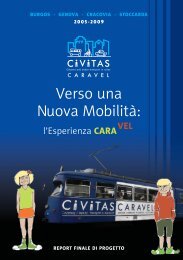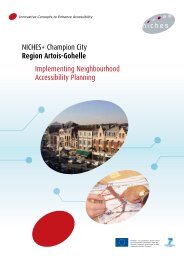VOYAGER Good Practice Case Studies - Rupprecht Consult
VOYAGER Good Practice Case Studies - Rupprecht Consult
VOYAGER Good Practice Case Studies - Rupprecht Consult
You also want an ePaper? Increase the reach of your titles
YUMPU automatically turns print PDFs into web optimized ePapers that Google loves.
progress on the French and European level and of studying the advantages travellers may<br />
experience when using a highly innovative, complete public transport system under real operating<br />
conditions. Furthermore, an additional offer of a bicycle lending and rental service at some stations<br />
of the LEO 2000 line (with 50 electric and 50 standard bicycles) has been provided.<br />
Another case study presents the successful driverless system from the city of Lille. Lille was<br />
the first city in the world to adopt a new form of fully automated urban metro. The VAL concept is a<br />
driverless guidance system and consists of rubber-tyred vehicles using an automated guideway,<br />
segregated from other road users for safety reasons, and allowing the greatest possible flexibility.<br />
A new type of vehicle technology is described in the case study on the ULEV-TAP - flywheel<br />
project, which is aimed at designing and assessing the flywheel energy storage system. This<br />
power generation system would partially replace the external supply of a mass-transit electric<br />
vehicle, light rail or trolleybus. ULEV-TAP is an abbreviation for Ultra Low Emission Vehicle -<br />
Transport using Advanced Propulsion. This is a rail vehicle in which a flywheel is used for storing<br />
braking energy that can be retrieved later while accelerating. Thus, the Prime Mover Unit, which is<br />
a gas turbine with a high-speed generator, has a significantly lower power rating than would be<br />
needed without flywheel, since it only has to deliver the average power demand.<br />
Impacts on horizontal issues<br />
The case studies on PT infrastructure and rolling stock are showing considerable impacts on the<br />
economic efficiency and effectiveness of the PT system (mainly by decreasing costs or by raising<br />
incomes through increased PT patronage) and therefore on the economic sustainability of PT. At<br />
the same time, most of the case studies have contributed to a better service quality and increased<br />
customer satisfaction, which means that also social benefits could be achieved. The use of<br />
innovative propulsion technologies, as presented in one case study can lead to environmental<br />
improvements related to pollution and resource consumption and therefore to more environmental<br />
sustainability.<br />
The example of the revitalisation of the bus line in Grenoble has shown, that the frequency of the<br />
bus service could be increased by 13% and commercial speed from 15.5 km/h to 17.4 km/h. 80%<br />
of time saving was due to the traffic light priority system. Patronage of the line increased by 18%<br />
over the same period during the previous year, which was far higher than the increase of 7%<br />
recorded for the whole network. Customer satisfaction appeared higher than that recorded two<br />
years before, regarding comfort, cleanliness, smooth driving. But also the drivers appreciated their<br />
new equipment and the dedicated lane gave them greater driving comfort, provided that it is not<br />
blocked.<br />
An example, that the modernisation of an interchange can result in a high degree of service<br />
improvements and customer satisfaction, is described in the Lund case study. In Lund, the new<br />
interchange facility is highly appreciated by all users. Travellers safety and security has been<br />
improved by restructuring the interchange surroundings and providing well lighted waiting and<br />
walking areas. Since cycling facilities have been improved and cyclists are authorised to use lifts<br />
within the interchange, travel distances and efforts can be reduced and cycling is more safe.<br />
The driverless system of Lille, called VAL, has proven to provide great economic benefits, because<br />
there is less need for personnel. The saving related to the marginal cost of a VAL km compared to<br />
a bus km is in the region of 1 to 3, mainly due to the reduced driver costs. However, since personal<br />
contact (mainly for security and information reasons) is highly appreciated by many customers, the<br />
reduced number of personnel can at the same time be seen as a social disadvantage. In terms of<br />
reliability and flexibility of the operation, the VAL system has shown good results. The adoption of<br />
the VAL concept in many French and foreign cities has consolidated the success of this light rail<br />
system. This driverless guidance system has also progressed in certain heavy metro projects, but<br />
with different technical approaches.<br />
16


